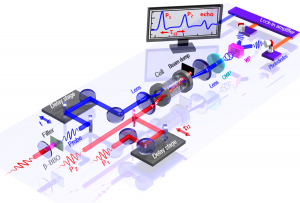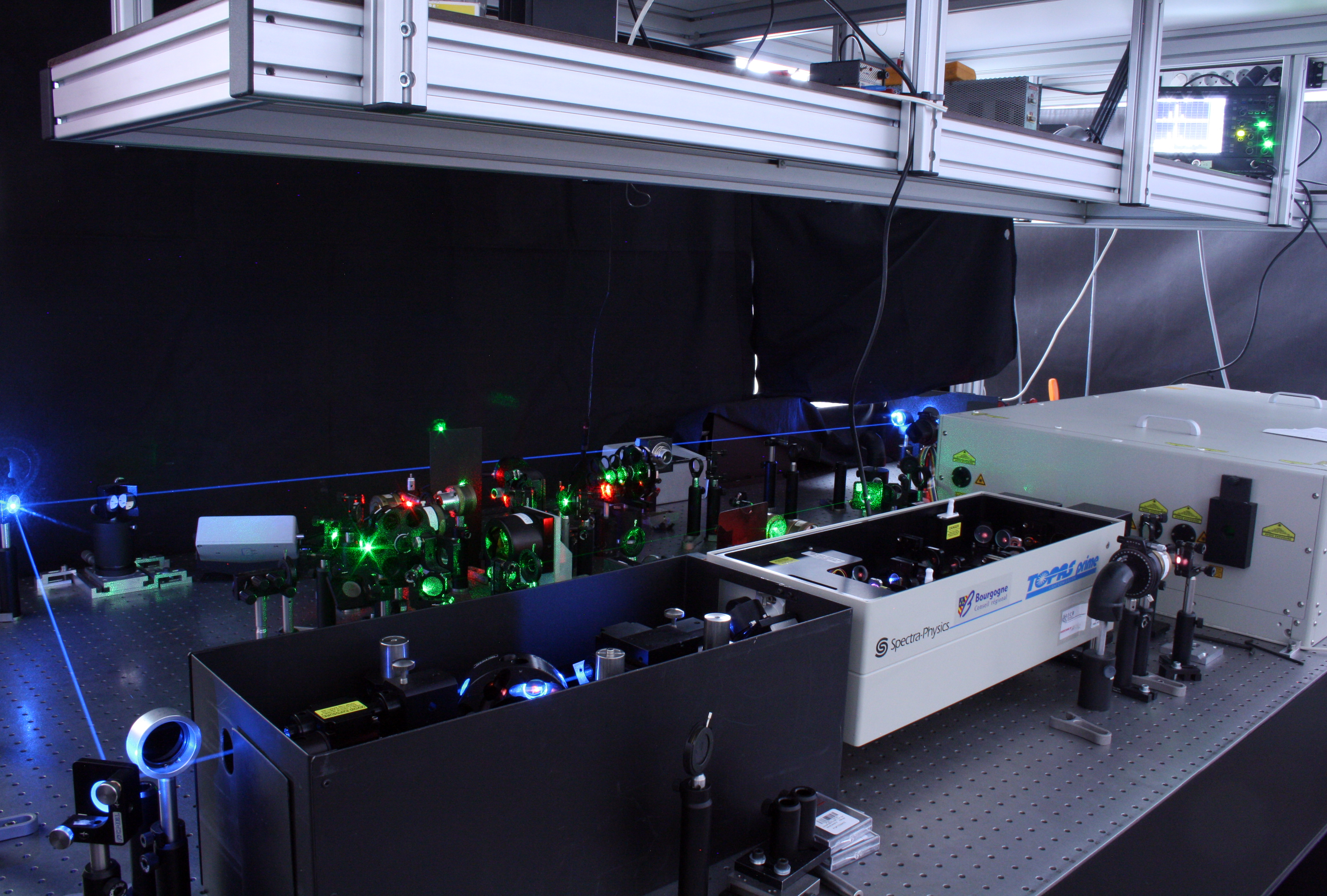Femtosecond Processes & Intense Lasers
Since 1999, the PFL team has developed a research activity in the field of the generation and exploitation of controlled molecular dynamics. With its pioneering work on optically probed laser-induced field-free molecular alignment and its expertise on control by pulse shaping techniques, the team has notably contributed to the development of a research topic becoming today the scientific target of several international leading groups. The originality of the group relies on the use of all optically probed short-pulse molecular alignment associated with close and open loop control strategies.

Highlights of the scientific achievements of the PFL group in strong field interactions of laser radiation with matter include:
- demonstration of optically probed field-free molecular alignment
- implementation of field-Free two-direction alignment of linear molecules
- development of novel approaches for the control and optimization of field-free molecular alignment by phase-shaped laser pulses
- implementation of three-dimensional molecular alignment using elliptically polarized laser pulses
- observation of high-order Kerr nonlinearities in gases and its consequences on short laser pulse propagation
- experimental implementation of laser-induced field-free permanent planar alignment of molecules
Research topics
Facilities
We have two femtosecond laser systems providing 100 fs pulses at the center wavelength of 800 nm. The first system (Thalès Alpha 1000 and 100) delivers pulses at a repetition rate of 1 kHz (pulse energy of about 600-700 μJ) and at a repetition rate of 100 Hz (pulse energy of about 8 -10 mJ). The second laser system (Spectra-Physics Solstice) provides up to 3.5 mJ pulses at 1 kHz. The last is complemented by an OPA (TOPAS) and options to cover the spectral range from UV to infrared (250 nm -11 mm). Two pulse shapers based on liquid crystals are available for optimization experiments with genetic algorithms.
These equipments are accompanied by devices for measurement of pulse characteristics : single-shot autocorrelator (duration), SPIDER (temporal profile and phase), spectrometers, power and energy meters, and spatial beam profiler.
The implementation of gaseous samples for the experiments is conducted in static cells (optionally high pressure and temperature) in a molecular beam (pulsed or continuous, coupled to a Time-of-flight mass spectrometer if applicable), or in an imaging spectrometer of electrons and ions.
Collaborations
Our research work involves collaborations at national and international level. We take the party in this report to only mention those which led to co-signed articles published or to be published between 2006 and 2010:
- University of Geneva, Switzerland, for the alignment and filamentation aspect
- IESL-FORTH Institute, Heraklion, Greece, for the ultra-fast dynamic look
- NRC Institute, Ottawa, Canada, for alignment and filamentation aspect
- Max-Planck Institute, Garching, Germany (for the ultra-fast dynamic look)
- ONERA Palaiseau, for the frequency-resolved spectroscopy aspect
- Lund Institute of Technology (LTH), Sweden, for the frequency-resolved spectroscopy aspect
- LISA, Université Paris VII, for the spectroscopy aspect resolved in frequency and time
- kc_data:
- a:8:{i:0;s:0:"";s:4:"mode";s:2:"kc";s:3:"css";s:0:"";s:9:"max_width";s:0:"";s:7:"classes";s:0:"";s:9:"thumbnail";s:0:"";s:9:"collapsed";s:0:"";s:9:"optimized";s:0:"";}
- kc_raw_content:
- [kc_row use_container="yes" _id="525033"][kc_column width="60.35%" _id="695375"][kc_column_text _id="410017"]
Femtosecond Processes & Intense Lasers
Since 1999, the PFL team has developed a research activity in the field of the generation and exploitation of controlled molecular dynamics. With its pioneering work on optically probed laser-induced field-free molecular alignment and its expertise on control by pulse shaping techniques, the team has notably contributed to the development of a research topic becoming today the scientific target of several international leading groups. The originality of the group relies on the use of all optically probed short-pulse molecular alignment associated with close and open loop control strategies.
[/kc_column_text][/kc_column][kc_column width="39.64%" _id="394122"][kc_column_text _id="824268"]Olivier FAUCHER
headgroup
olivier.faucher@u-bourgogne.fr
[/kc_column_text][/kc_column][/kc_row][kc_row use_container="yes" _id="606317" cols_gap="{`kc-css`:{}}" force="__empty__" animate="fadeInRight||"][kc_column width="12/12" video_mute="no" _id="637465"][kc_spacing height="30px" _id="965011"][kc_single_image image_size="full" _id="794891" image_source="media_library" image="11267"][kc_spacing height="20px" _id="764274"][/kc_column][/kc_row][kc_row use_container="yes" _id="942596" cols_gap="{`kc-css`:{}}" force="__empty__" animate="fadeInLeft||"][kc_column width="56.3%" _id="215104"][kc_column_text _id="179820"]
Phone : +33 (0)3 80 39 59 84Highlights of the scientific achievements of the PFL group in strong field interactions of laser radiation with matter include:
- demonstration of optically probed field-free molecular alignment
- implementation of field-Free two-direction alignment of linear molecules
- development of novel approaches for the control and optimization of field-free molecular alignment by phase-shaped laser pulses
- implementation of three-dimensional molecular alignment using elliptically polarized laser pulses
- observation of high-order Kerr nonlinearities in gases and its consequences on short laser pulse propagation
- experimental implementation of laser-induced field-free permanent planar alignment of molecules
Team members
[/kc_column_text][kc_spacing height="20" _id="99526"][kc_column_text _id="943859"]{slide=Permanents}
- Bejot Pierre, Research fellow
- Billard Franck, Research engineer
- Chaussard Frédéric, Lecturer
- Faucher Olivier, Professor (Team coordinator)
- Hertz Edouard, Lecturer
{/slide}
[/kc_column_text][kc_column_text _id="675241"]{slide=Non-permanents}
- Manon Bournazel, PhD student
{/slide}
[/kc_column_text][kc_column_text _id="952618"]{slide=Previous members}
- Berger Hubert, Professor
- Robert Saint-Loup, Research engineer
- Karras Gabriel, Postdoctoral researcher
- Andral Ugo (Thesis presented in Dec. 2016)
- Julien Doussot (Thesis presented in Dec. 2017)
- Thomas Vieillard (Thesis presented in June 2011)
- Ronald Tehini (Thesis presented in Dec. 2010)
- Vincent Loriot (Thesis presented in 2008)
- Arnaud Rouzée (Thesis presented in Oct. 2007)
- Vincent Renard (Thesis presented in June 2005)
- Matthias Renard (Thesis presented in Sept. 2004)
{/slide}
[/kc_column_text][/kc_column][/kc_row][kc_row use_container="yes" _id="122339" cols_gap="{`kc-css`:{}}" force="__empty__" animate="fadeInRight||"][kc_column width="12/12" video_mute="no" _id="440512"][kc_spacing height="30px" _id="932538"][kc_column_text _id="564162"]Research topics
[/kc_column_text][kc_spacing height="20" _id="286518"][/kc_column][/kc_row][kc_row use_container="yes" _id="779375" cols_gap="{`kc-css`:{}}" force="__empty__" animate="fadeInRight||"][kc_column width="12/12" video_mute="no" _id="347942"][kc_spacing height="30px" _id="235968"][/kc_column][/kc_row][kc_row use_container="yes" _id="527618" cols_gap="{`kc-css`:{}}" force="__empty__" css_custom="{`kc-css`:{}}" animate="fadeInRight||"][kc_column width="44.6%" _id="755694"][kc_spacing height="20px" _id="419028"][kc_column_text _id="394523"]{slide=Laser induced molecular alignment}
Aligning molecules using femtosecond laser pulses is central to our team's work. This is in a pioneering study published in 2003 [Phys. Rev. Lett. 90, 153601, 2003] that we have shown that a gas of aligned molecules can be produced and measured very precisely by "all-optical" methods.
Our contribution to the field since 2006 has first been to develop and improve new optical methods that allow quantitative measurement of molecular alignments of dense gaseous media. Our measurement techniques are non-invasive. They are based on the change in the refractive index of the medium induced by the orientation of molecular dipoles following alignment. Their strengths lie in the precision, speed and adaptability to a wide range of experimental conditions (type of molecule, temperature and density of gaseous media, polarization, direction of propagation and intensity of laser fields)
{/slide}
[/kc_column_text][/kc_column][kc_column width="10.49%" _id="10007"][/kc_column][kc_column width="44.89%" _id="47757"][kc_spacing height="20px" _id="887280"][kc_column_text _id="971672"]{slide=Laser filamentation}
Atoms and / or molecules subjected to intense laser fields (10-100 TW / cm2) and non-resonating exhibit highly non-linear dynamics which have motivated important studies both experimental and theoretical and led to the observation of phenomena such as above-threshold ionization (ATI), generation of high order harmonics (HHG), generation of attosecond pulses or filamentation. Currently, our activity is devoted to the study of these highly non-linear phenomena both from a theoretical and experimental point of view.
{/slide}
[/kc_column_text][/kc_column][/kc_row][kc_row use_container="yes" _id="989905" cols_gap="{`kc-css`:{}}" force="__empty__" animate="fadeInRight||"][kc_column width="12/12" video_mute="no" _id="690845"][kc_spacing height="30px" _id="26412"][/kc_column][/kc_row][kc_row use_container="yes" _id="49094" cols_gap="{`kc-css`:{}}" force="__empty__" css_custom="{`kc-css`:{}}" animate="fadeInRight||"][kc_column width="44.6%" _id="820742"][kc_single_image image_size="medium" _id="42417" image="23570" image_source="media_library"][kc_column_text _id="885281"]{slide=Observing collisions beyond the secular approximation limit}
Understanding the interactions of a quantum system with its environment is essential for understanding natural phenomena as well as quantum technologies of the future. The unavoidable coupling of the quantum system to its environment results in a decoherence often described within the secular approximation. Our team and colleagues from the University of Paris-Saclay and East China University of Shanghai have demonstrated the limit of this approximation when molecular rotators are exposed to collisional relaxation [1,2]. The experimental results were obtained thanks to the development of a strategy based on molecular alignment echoes used for probing the relaxation rotational coherences on time scales comparable or even less than the duration of a collision. The reduction of the short time compared to long time dissipation, successfully confronted with calculations of quantum and classical dynamics [3], results from the constructive effect of nonsecular transfers along rotational coherences, acting during the early relaxation stage of the system, challenging the widespread idea that collisions necessarily act like losses.
[1] J. Ma, H. Zhang, B. Lavorel, F. Billard, E. Hertz, J. Wu, C. Boulet, J.-M. Hartmann, O. Faucher, Observing collisions beyond the secular approximation limit, Nature Commun. 10, 5780 (2019).
[2] O. Faucher and Jean-Michel Hartmann. Quand des collisions ralentissent la dissipation, INP website of the CNRS, February 12, 2020. Link :https://www.inp.cnrs.fr/fr/cnrsinfo/quand-des-collisions-ralentissent-la-dissipation
[3] J.M. Hartmann, J. Ma, T. Delahaye, F. Billard, E. Hertz, J. Wu, B. Lavorel, C. Boulet, O. Faucher, Molecular alignment echoes probing collision-induced rotational-speed changes, Phys. Rev. Research 2, 023247 (2020).
{/slide}
[/kc_column_text][/kc_column][kc_column width="10.49%" _id="720469"][/kc_column][kc_column width="44.89%" _id="427991"][kc_spacing height="20px" _id="4144"][kc_column_text _id="110183"]{slide=Collisional dynamics in gas mixtures}
This activity concerns the study of relaxation processes, collisional enlargement mechanisms and their consequences too well in the field of frequencies (modeling of spectral profiles than in the time domain. We now have a in-depth understanding and spectral and temporal modeling very fine view of these complex collisional mechanisms.
It is remarkable to note that the study of these problems collisional allows you to join the other team theme on molecular alignment. Indeed, two alignment components are
generally observed: one is transient and appears with a specific period, the other corresponds to a so-called permanent alignment. Theoretical studies have shown that relaxation processes are different for these two components. We can thus obtain fairly comprehensive information on these different processes.{/slide}
[/kc_column_text][/kc_column][/kc_row][kc_row use_container="yes" _id="395655" cols_gap="{`kc-css`:{}}" force="__empty__" animate="fadeInRight||"][kc_column width="12/12" video_mute="no" _id="674152"][kc_spacing height="30px" _id="154922"][/kc_column][/kc_row][kc_row use_container="yes" _id="557888" cols_gap="{`kc-css`:{}}" force="__empty__" css_custom="{`kc-css`:{}}" animate="fadeInRight||"][kc_column width="44.6%" _id="552699"][kc_spacing height="20px" _id="365639"][kc_column_text _id="945441"]{slide=Applications and development}
- Micro-machining
- Surface structuring
{/slide}
[/kc_column_text][/kc_column][kc_column width="10.49%" _id="476400"][/kc_column][kc_column width="44.89%" _id="373343"][kc_spacing height="20px" _id="226600"][kc_column_text _id="465243"]{slide=Other theme}
{/slide}
[/kc_column_text][/kc_column][/kc_row][kc_row use_container="yes" _id="313879" cols_gap="{`kc-css`:{}}" force="__empty__" animate="fadeInRight||"][kc_column width="12/12" video_mute="no" _id="420002"][kc_spacing height="30px" _id="474060"][/kc_column][/kc_row][kc_row use_container="yes" _id="157744" cols_gap="{`kc-css`:{}}" force="__empty__" animate="fadeInLeft||"][kc_column width="49.82%" _id="848916"][kc_column_text _id="319007"]Facilities
We have two femtosecond laser systems providing 100 fs pulses at the center wavelength of 800 nm. The first system (Thalès Alpha 1000 and 100) delivers pulses at a repetition rate of 1 kHz (pulse energy of about 600-700 μJ) and at a repetition rate of 100 Hz (pulse energy of about 8 -10 mJ). The second laser system (Spectra-Physics Solstice) provides up to 3.5 mJ pulses at 1 kHz. The last is complemented by an OPA (TOPAS) and options to cover the spectral range from UV to infrared (250 nm -11 mm). Two pulse shapers based on liquid crystals are available for optimization experiments with genetic algorithms.
These equipments are accompanied by devices for measurement of pulse characteristics : single-shot autocorrelator (duration), SPIDER (temporal profile and phase), spectrometers, power and energy meters, and spatial beam profiler.
The implementation of gaseous samples for the experiments is conducted in static cells (optionally high pressure and temperature) in a molecular beam (pulsed or continuous, coupled to a Time-of-flight mass spectrometer if applicable), or in an imaging spectrometer of electrons and ions.
[/kc_column_text][/kc_column][kc_column width="9.24%" _id="168379"][/kc_column][kc_column width="40.88%" _id="262082"][kc_spacing height="70px" _id="998586"][kc_single_image image_size="full" _id="282202" image_source="media_library" image="12149" on_click_action="lightbox" caption="Laser Spectra-Physics Solstice utilisé pour le projet et délivrant des impulsions de 100 femtosecondes à 800nm de 3.5mJ au maximum"][/kc_column][/kc_row][kc_row use_container="yes" _id="263900" cols_gap="{`kc-css`:{}}" force="__empty__" css_custom="{`kc-css`:{}}" animate="fadeInUp||"][kc_column width="20.11%" video_mute="no" _id="447881"][kc_spacing height="30px" _id="505276"][/kc_column][kc_column width="59.91%" video_mute="no" _id="59316"][kc_spacing height="30px" _id="695541"][kc_column_text _id="512375"]Collaborations
Our research work involves collaborations at national and international level. We take the party in this report to only mention those which led to co-signed articles published or to be published between 2006 and 2010:
- University of Geneva, Switzerland, for the alignment and filamentation aspect
- IESL-FORTH Institute, Heraklion, Greece, for the ultra-fast dynamic look
- NRC Institute, Ottawa, Canada, for alignment and filamentation aspect
- Max-Planck Institute, Garching, Germany (for the ultra-fast dynamic look)
- ONERA Palaiseau, for the frequency-resolved spectroscopy aspect
- Lund Institute of Technology (LTH), Sweden, for the frequency-resolved spectroscopy aspect
- LISA, Université Paris VII, for the spectroscopy aspect resolved in frequency and time

